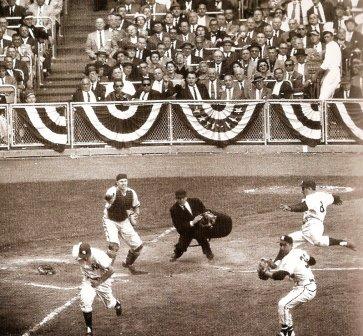The Sacrifice Bunt
by Dan Kelley
(Louisville, KY)

Make Your Opponent Defend The Entire Field

Jackie Robinson Stealing Home

Squeeze Bunt 1957 World Series

Sacrifice Bunt To Move Runners 90 Feet Closer To Home Plate
Dan asked: Why do you provide instruction on sacrifice bunting when doing so, rather than letting the batter swing away, can be shown to result in fewer runs for the team at bat?
Rick answered: Dan, thank you for your question.
There are numerous situations for having baseball players be proficient in bunting the baseball.
I would be interested in learning more about your statement that, "using the sacrifice bunt, rather than letting the batter swing away, can be shown to result in fewer runs for the team at bat".
One of the driving factors for bunting a runner into scoring position, or, if already in scoring position, bunting that runner to 3B, is that there are 25 ways a runner can score from third base, that they are unable to score from 2B on.
While those 25 situations do not always appear, without a runner on 3B, they will not be a factor. When an offense puts runners into scoring position, be it 2B or 3B, pressures on the defense become greater and the margin for defensive mistakes is higher.
It is my belief that managers and coaches have a responsibility to create an offensive philosophy within which all of their personnel can be successful.
By having an offensive philosophy which allows a team to make the best use of an individual players talents, in the situation presented in that particular at bat, the offense has a better opportunity to be successful.
When teams make their opponent defend the entire field, from 3 feet in front of home plate, all the way to the outfield fences, foul line to foul line, it requires the defense to make adjustments to whatever develops as the pitch is thrown.
Offensive teams which sit back and wait for the big hit require the defense to do nothing more than sit back and make a play.
One example of the many options available to an offense: Runners at first and third...
Pitcher checks the runners, then starts his motion. On that motion, the runner breaks from first base, straight steal of second base. That requires either the SS or 2B to cover second base.
At the same time, the batter squares to bunt. This situation now has gone from a steal, possible double steal, to a run and bunt.
Batter pushes the bunt up the first base side, towards the area the 2B has left, either to cover 2B, or to come and cover first base, as the 1B must charge to attempt to field the bunt.
As the ball is bunted, if it's on the ground, and not right back to the pitcher, the runner from 3B breaks for home and scores.
Best case scenario for the offense, run from 3B scores, runner from 1B rolls around second and ends up on third, as the 3b has come to field the bunt, no one is at third. Batter bunts the ball past the pitcher and first baseman, towards where the 2B started the play before the pitch was made.
Still have runners on first and third, scored a run, no outs recorded.
At the least, run scores, runner from first is safe at second, batter is out at first.
Ty Cobb, the legend, figured that making a play on defense was at least 5 times harder than making an offensive play. His theory, keep putting pressure on the defense, mistakes will happen.
Even at the MLB level, player's abilities differ greatly, and there are players who will be more successful within a philosophy which allows them to use their innate talents, a win/win for the players and the team.
Make Your Opponent Play The Game!
Yours in baseball,
Rick










